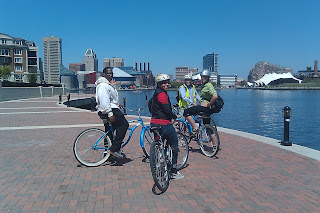 |
| West Covington Park and Hanover Street Bridge (Photo Jake Smith) |
The question comes up most frequently in the context of abandoned properties, disinterested neighborhoods and demolition. Many suggest to bulldoze it all and turn it into a beautiful park.
But the matter of Baltimore's parks is not simply one of quantity (enough green space per household), it is also a matter of quality and specifically one of meeting needs and demands that didn't exist in the same way when Baltimore's park system was initially created.
Just think of the dog parks, the trail systems for runners or the bike masterplan, all open space activities that no comprehensive plan ever included until the most recent decade. Especially the reconsideration of the waterfront as a recreational amenity has brought us innovation and new ideas about parks and open space.
 |
| Waterfront promenade at Ritz Carlton development (photo: Bikemore) |
The nearly 5 miles Inner Harbor Waterfront promenade was first and idea and then a patchwork until now it is an almost complete network of trails and spaces for walkers, runners and (in places) bicyclists that is on par with Chicago's Lake Shore trails. The Jones Falls trail took the great parks of Cylburn and Druid Hill and linked them together with access all the way to downtown with connections to the Middle Branch and the other great stream trail system named after the Gwynns Falls.
The new West Covington Park at the foot of the Hanover Street bridge and across from Under Armour's new maker space at "City Garage" is designed by Baltimore architecture firm Ayers Saint Gross. It is an example of the beginning of a second waterfront trail and park system that just recently began to emerge and includes Port Covington and Under Armour's large campus plans as well as the currently still unplanned Westport site with linage to the already existing trails coming down to Westport and Cherry Hill from the Gwynns Falls and the Middle Branch Park.
 |
| Promenade at Union Wharf Fells Point (Photo: Union Wharf) |
The park was funded by a mix of state and federal moneys as an environmental demonstration project, to show how other brownfield sites could be cleaned up and become assets for public use. It offers residents of South Baltimore an new perspective of the Hanover Street Bridge, the Middle Branch waterfront and the Cherry Hill shoreline across the water. The 19 acre park offers a new place to run, walk the dog or just sit and contemplate. The park is quite "architectural" in its design (playing a lot with hard geometric forms) but with plenty of landscaping it will soften as soon as some of the plant materials grows a bit more. The Brew reported the price tag of the park to be $10.3 million. The land is owned by the Aquarium after a sale from the city under former Mayor Dixon. However it presents itself as open as any public park.
In the consideration what makes Baltimore great and what it offers to old timers and new millennials choosing this city as their new home Baltimore, its splendid historic parks, its trails and its public access to a cleaned up and rediscovered waterfront are invaluable assets.
 |
| View of the Hanover Bridge from West Covington Park at night (photo ArchPlan) |
These open spaces add value even without anybody paying taxes on the land itself, without commercial vendors on the spaces and even though the creation of them took taxpayer funds.
Klaus Philipsen, FAIA
 |
| Middle Branch Park near Cherry Hill |
Baltimore Brew article about the problems of the park's creation
Brew article about the quite opening of the park
 |
| Jones Falls Trail Map |
No comments:
Post a Comment